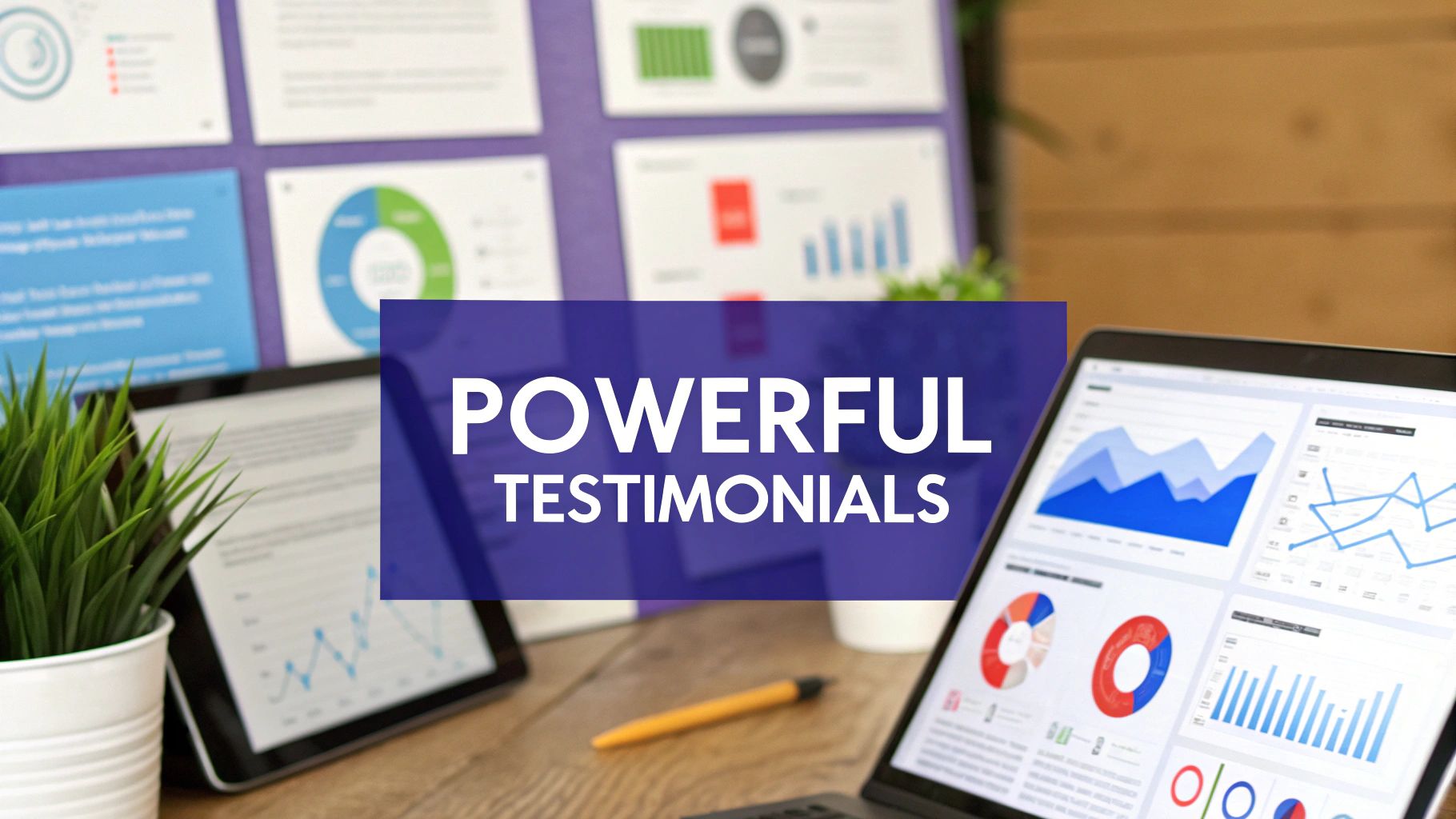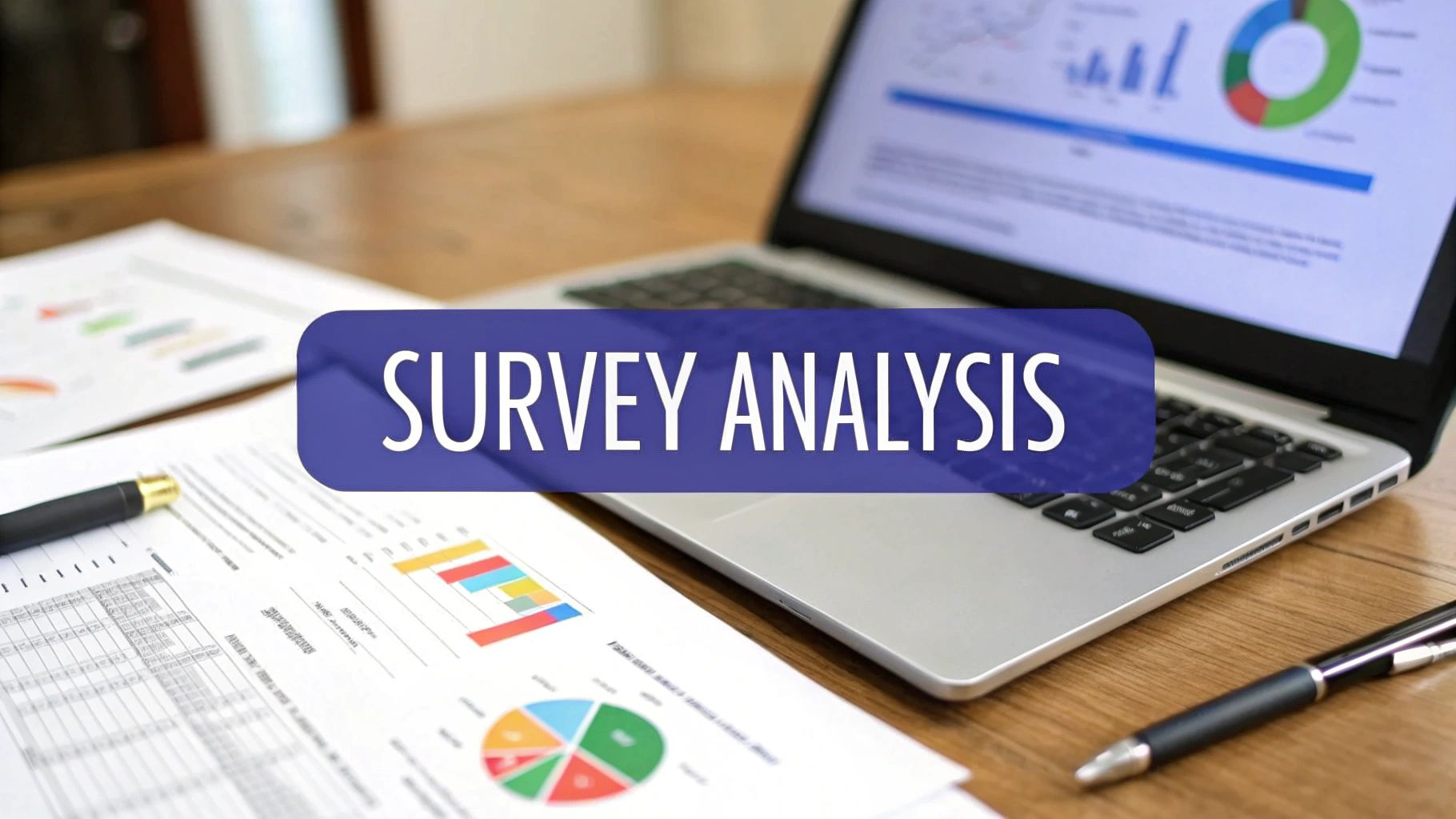12 Best Feedback Form Templates for SaaS in 2025
Discover 12 powerful feedback form templates to gather user insights. Download, embed, and customize forms to reduce churn and improve your SaaS product.
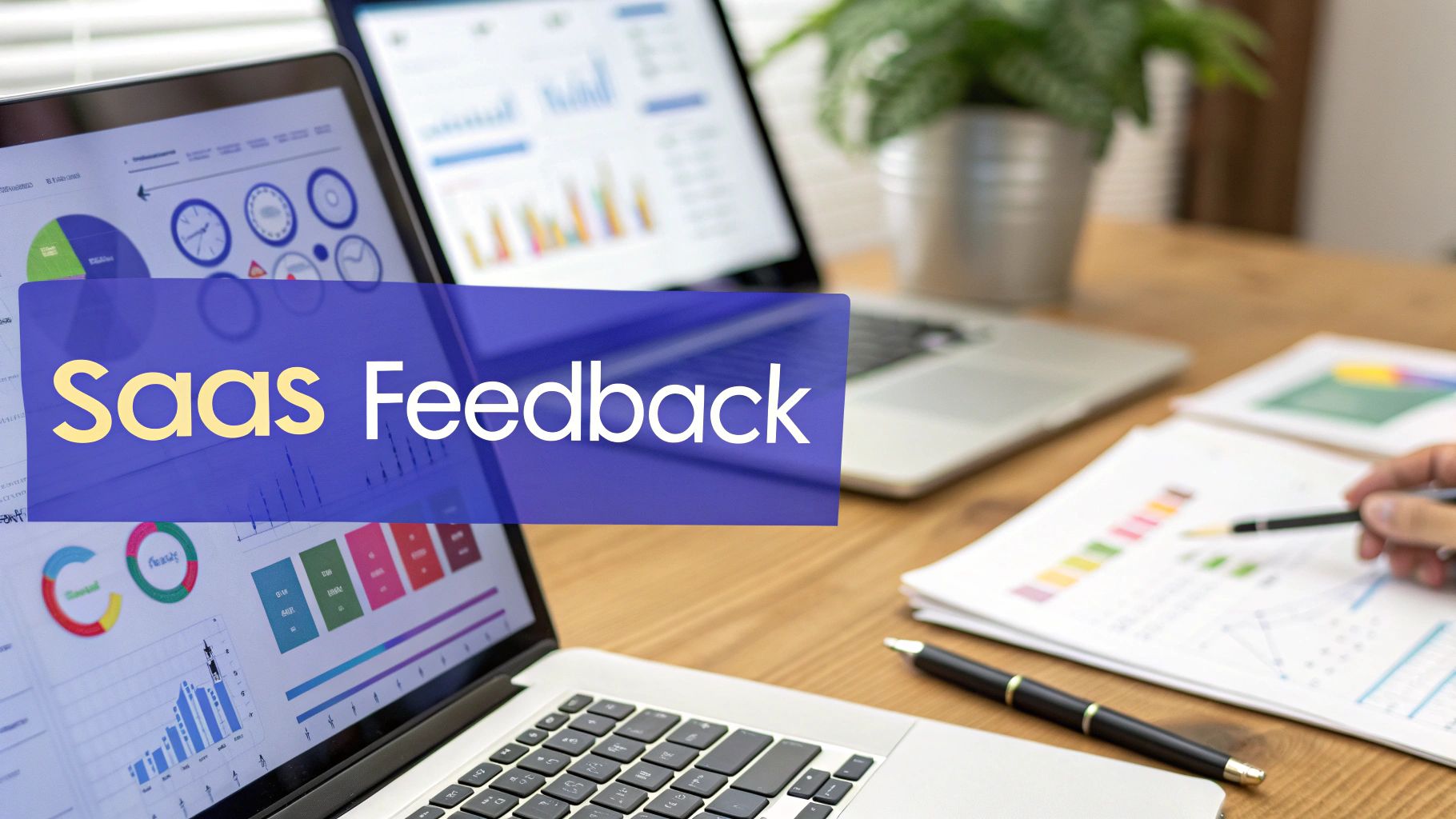
If you are a SaaS business, understanding your user is everything. Yet, many teams rely on generic, one-size-fits-all feedback forms that yield low response rates and superficial insights. This approach misses the critical nuances of the user journey-why a user is churning, what makes a feature indispensable, or what friction points are costing you revenue. To get actionable data, you need targeted, well-designed feedback mechanisms that are context-aware and easy for users to complete.
A generic form with poor design often fails before it's even seen. A low-quality user experience can discourage users from sharing their thoughts, much like a poorly designed email gets ignored. Applying effective email template design tips to your forms-focusing on clarity, branding, and mobile optimization-can significantly boost completion rates. The core problem isn't just about asking questions; it's about asking the right questions in the right way.
This resource moves beyond basic examples to provide a curated list of 12 powerful feedback form templates specifically chosen for SaaS teams. We analyze each platform-from dedicated builders like Jotform and Typeform to integrated solutions like ClickUp and Zendesk-for its unique strengths and ideal use cases. You will find screenshots, direct links, and practical implementation notes for each option. Our goal is to help you quickly identify the best tool to capture specific feedback, whether it's for:
- New user onboarding
- Post-demo follow-ups
- Feature validation surveys
- Customer satisfaction (CSAT) scores
- Churn and cancellation reasons
This guide will help you transform feedback from a passive data point into your most powerful growth engine.
1. Jotform
Jotform is a powerhouse in the online form-building space, primarily due to its sheer volume and variety of templates. For SaaS teams looking for robust feedback form templates, Jotform offers an extensive library covering nearly every conceivable use case, from Net Promoter Score (NPS) surveys to detailed product feature requests and post-support interaction evaluations.
The platform's key differentiator is its highly intuitive drag-and-drop editor. This allows product and marketing teams to quickly customize a base template to match their brand's visual identity and specific data collection needs without writing a single line of code. The user experience is smooth, enabling rapid deployment of forms.
Use Case and Implementation
- Best For: Teams needing a wide variety of customizable forms for different touchpoints, like post-onboarding feedback, beta testing input, and general customer satisfaction.
- Implementation Tip: Utilize Jotform's conditional logic feature. You can create dynamic forms that show or hide questions based on a user's previous answers, leading to a more personalized experience and higher completion rates. For example, if a user rates their satisfaction as "low," a follow-up text box can automatically appear asking for specific reasons.
- Integration: Jotform excels with its vast integration library, connecting seamlessly with tools like Slack, Trello, Google Sheets, and various CRMs. This allows feedback data to be automatically piped into your existing workflows, saving significant manual effort. For a deeper analysis of its capabilities, you can learn more about Jotform's user reviews and comparisons.
Platform Breakdown
FeatureAssessmentEase of UseExcellent. The drag-and-drop interface is user-friendly for non-technical users.CustomizationHigh. Extensive options for fields, design, and advanced logic.Pricing ModelFreemium. The free plan is limited to 5 forms and 100 monthly submissions. Paid plans are required for higher volumes and removing Jotform branding.Unique OfferingIts massive template library (over 10,000+) is unmatched in the industry.
Website: Jotform Feedback Form Templates
2. Typeform
Typeform redefines the feedback form by transforming it into an interactive conversation. Instead of presenting a static list of questions, its one-question-at-a-time interface makes the experience feel more personal and less like a chore. For SaaS companies looking for high-quality feedback form templates that maximize engagement, Typeform is a leading choice, especially for user-facing surveys where first impressions matter.
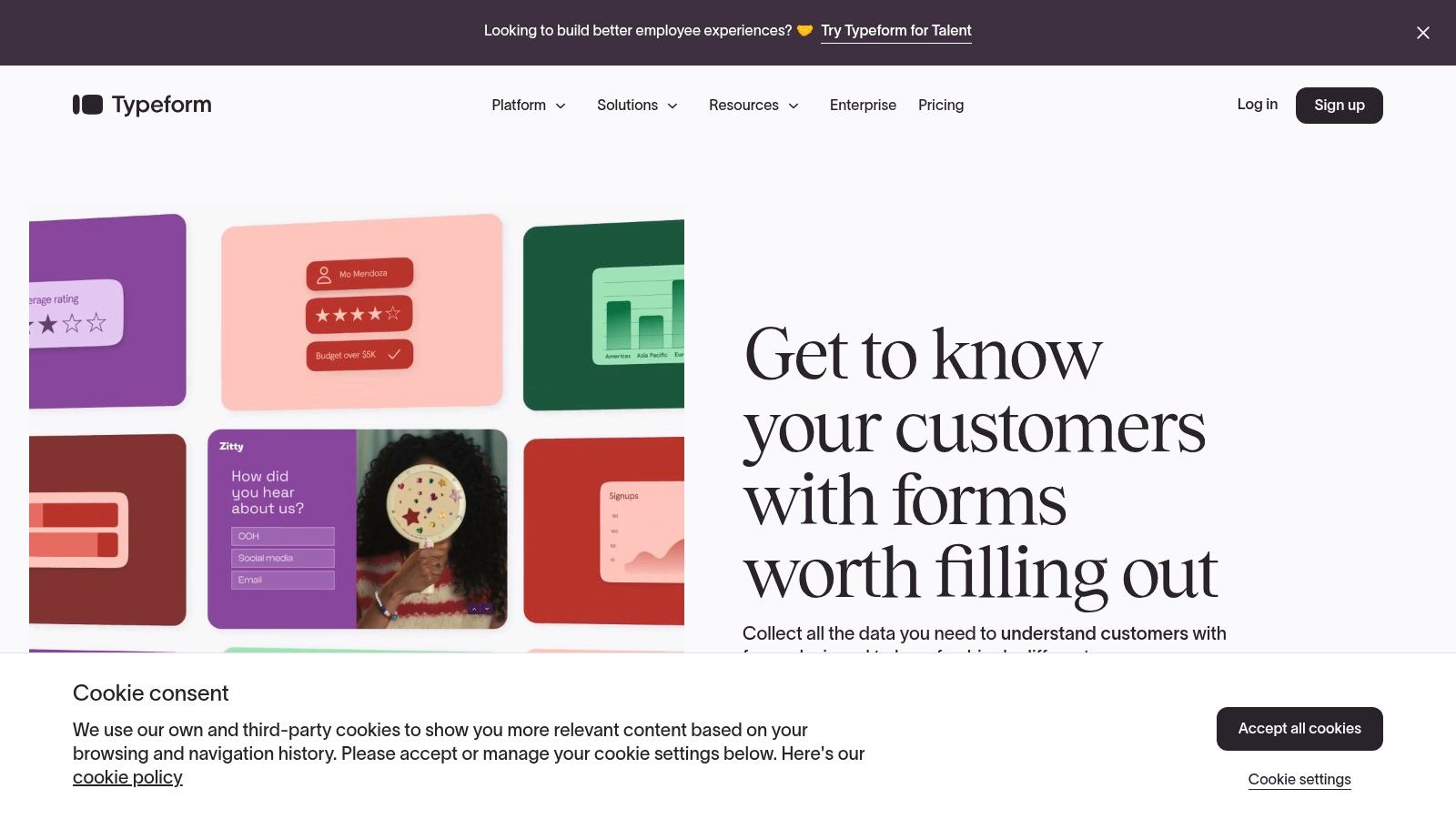
The platform’s standout feature is its beautiful, minimalist design and smooth animations, which are proven to boost completion rates. This design-first approach ensures that the feedback process itself reflects the quality and user-friendliness of your own product, creating a cohesive brand experience from start to finish.
Use Case and Implementation
- Best For: Customer-facing feedback, such as post-demo surveys, event feedback, or user research questionnaires where making a strong, positive impression is crucial.
- Implementation Tip: Leverage Typeform's "Logic Jumps." This powerful feature allows you to create branching paths in your form, tailoring subsequent questions to a user's specific feedback. For instance, you can direct happy users to a review site while asking dissatisfied users for more detailed input, all within the same form.
- Integration: Typeform connects with hundreds of popular apps, including Slack, HubSpot, Mailchimp, and Zapier. This allows you to instantly channel customer feedback into your CRM or project management tools, enabling rapid response and action from your team. For a detailed look at its integrations and user ratings, you can explore in-depth reviews of Typeform.
Platform Breakdown
FeatureAssessmentEase of UseExcellent. The live-preview editor is intuitive and makes form creation simple and visually rewarding.CustomizationHigh. Strong design options, but less granular field-level control than some competitors.Pricing ModelFreemium. The free plan is quite restrictive with a 10-question and 10-response-per-month limit. Paid plans are necessary for logic jumps and higher volumes.Unique OfferingIts conversational, one-question-at-a-time format creates a highly engaging user experience that significantly boosts response rates.
Website: Typeform
3. SurveyMonkey
SurveyMonkey is a titan in the online survey industry, and for good reason. It provides a robust platform for creating detailed feedback form templates that are backed by powerful analytics. While known for general surveys, its offerings are perfectly suited for SaaS teams looking to gather in-depth qualitative and quantitative data, from customer satisfaction (CSAT) to feature prioritization and churn analysis.
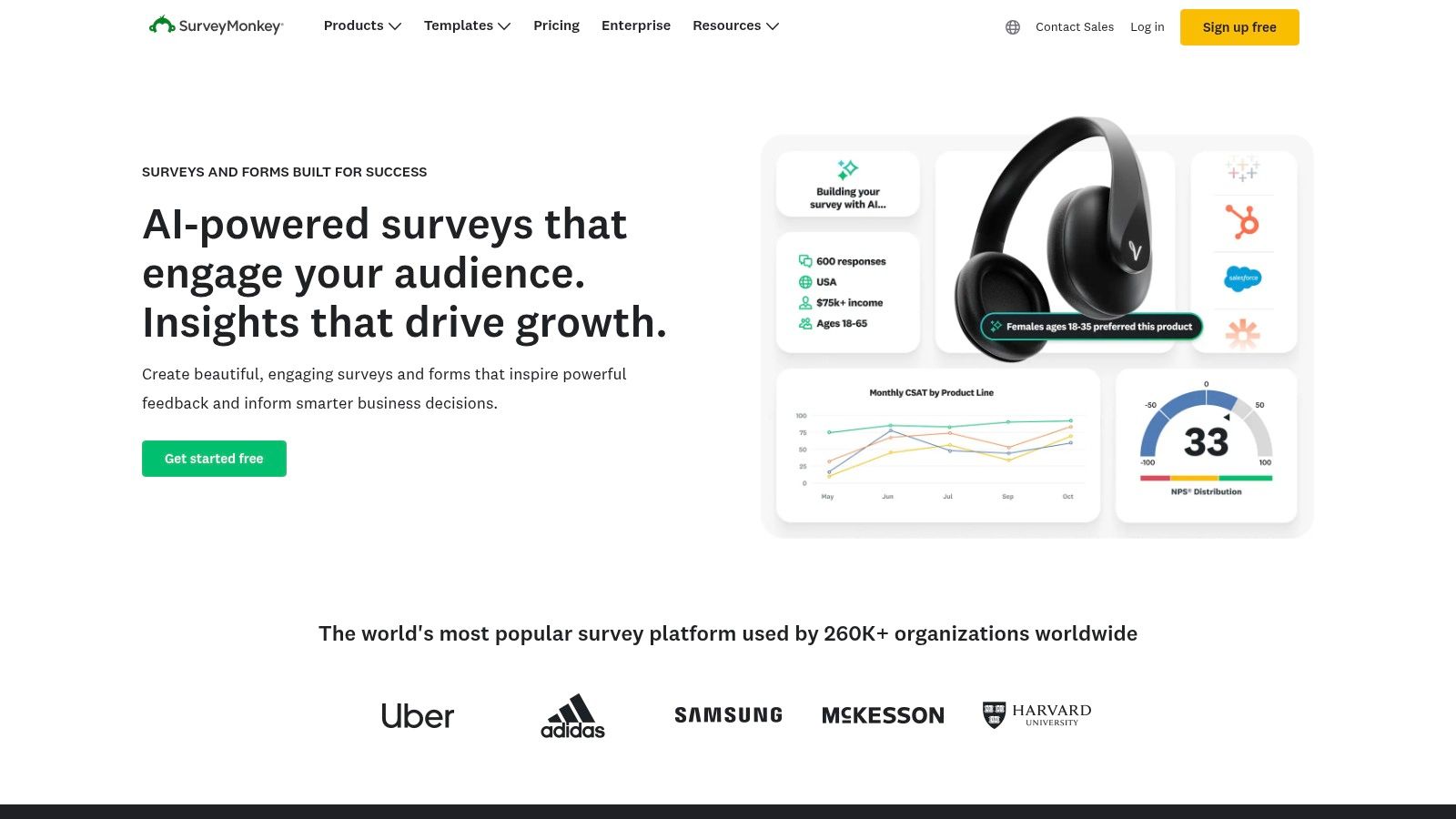
The platform's main advantage is its analytical engine. It doesn’t just collect data; it helps you understand it. Features like real-time results, text analysis, and data filtering empower teams to quickly identify trends and sentiments from user feedback without needing a separate business intelligence tool.
Use Case and Implementation
- Best For: Teams that prioritize data analysis and need to translate feedback into actionable insights. It's ideal for running comprehensive voice-of-the-customer programs or detailed post-churn surveys.
- Implementation Tip: Leverage SurveyMonkey’s question and page-skip logic. For a user feedback form, you can guide users down different paths based on their role (e.g., admin vs. standard user) or their product usage frequency, ensuring the questions are always relevant.
- Integration: SurveyMonkey connects with essential business applications like Salesforce, Marketo, and Mailchimp. This allows you to enrich customer profiles in your CRM with fresh feedback data or trigger surveys based on marketing campaign interactions. To see how this can be applied in practice, you can explore this guide to creating an effective exit survey.
Platform Breakdown
FeatureAssessmentEase of UseVery Good. The interface is clean and easy to navigate, though its advanced features have a slight learning curve.CustomizationGood. Offers solid customization for questions and logic, but design options are less flexible than some dedicated form builders.Pricing ModelFreemium. The free plan is quite restrictive, limiting you to 10 questions and only viewing the first 25 responses per survey. Paid plans unlock essential features.Unique OfferingIts powerful, built-in analytics and reporting suite is a key differentiator, providing deep insights directly within the platform.
Website: SurveyMonkey Templates
4. Formstack
Formstack is a versatile online form builder that shines in its ability to not just collect data but also automate the workflows that follow. For SaaS companies looking for feedback form templates, Formstack provides a secure and robust solution designed to streamline processes from initial submission to final action, making it a strong contender for teams focused on operational efficiency.
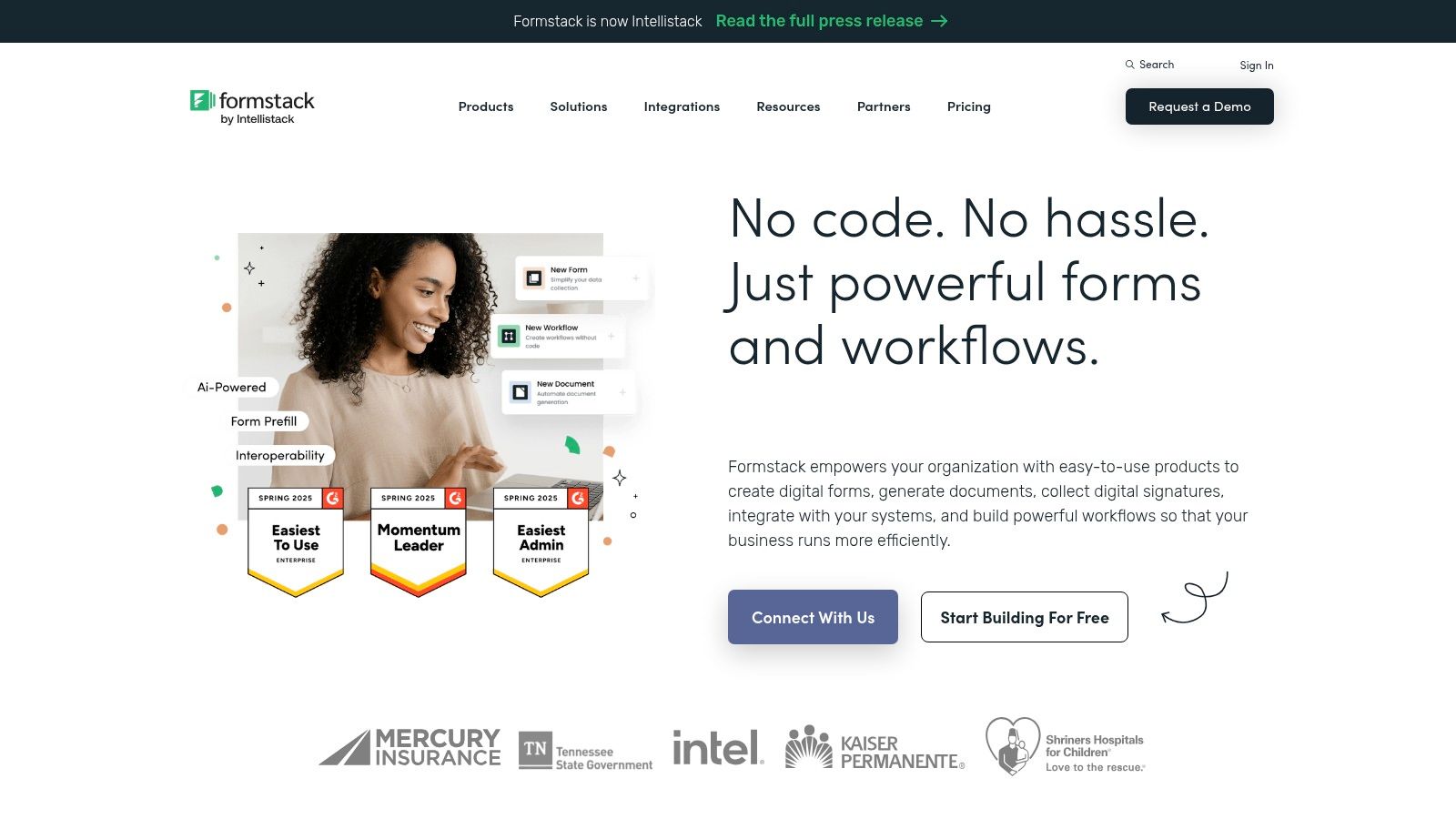
The platform differentiates itself with a heavy emphasis on data security and compliance (like HIPAA), making it ideal for industries handling sensitive information. Its drag-and-drop builder is intuitive, allowing teams to quickly adapt a standard customer satisfaction survey or a detailed bug report form to fit their precise needs.
Use Case and Implementation
- Best For: Teams that need to connect feedback directly to complex internal workflows, such as automatically creating a support ticket, updating a CRM record, and notifying a product manager simultaneously.
- Implementation Tip: Leverage Formstack's workflow automation features. You can design multi-stage approval processes directly from a form submission. For instance, negative feedback could automatically trigger an approval step for a customer success manager before being escalated to the product team.
- Integration: Formstack offers powerful native integrations with platforms like Salesforce, HubSpot, and various payment gateways. This allows you to build sophisticated systems, such as collecting feedback and then routing users to different follow-up actions based on their input, all within a single, cohesive environment.
Platform Breakdown
FeatureAssessmentEase of UseVery Good. The builder is clean and easy to navigate for most users.CustomizationHigh. Provides solid options for form fields, branding, and conditional logic.Pricing ModelSubscription-based. No free plan is offered. Pricing tiers are higher than many competitors, aimed at businesses with more complex needs.Unique OfferingIts integrated workflow automation and strong focus on data security and compliance features set it apart.
Website: Formstack
5. Venngage
Venngage carves out a unique niche in the feedback form space by prioritizing aesthetics and visual communication. While not a dedicated form builder, it provides a suite of beautifully designed feedback form templates that are perfect for teams wanting to present their surveys as part of a polished, branded document or infographic, rather than a standalone interactive form.
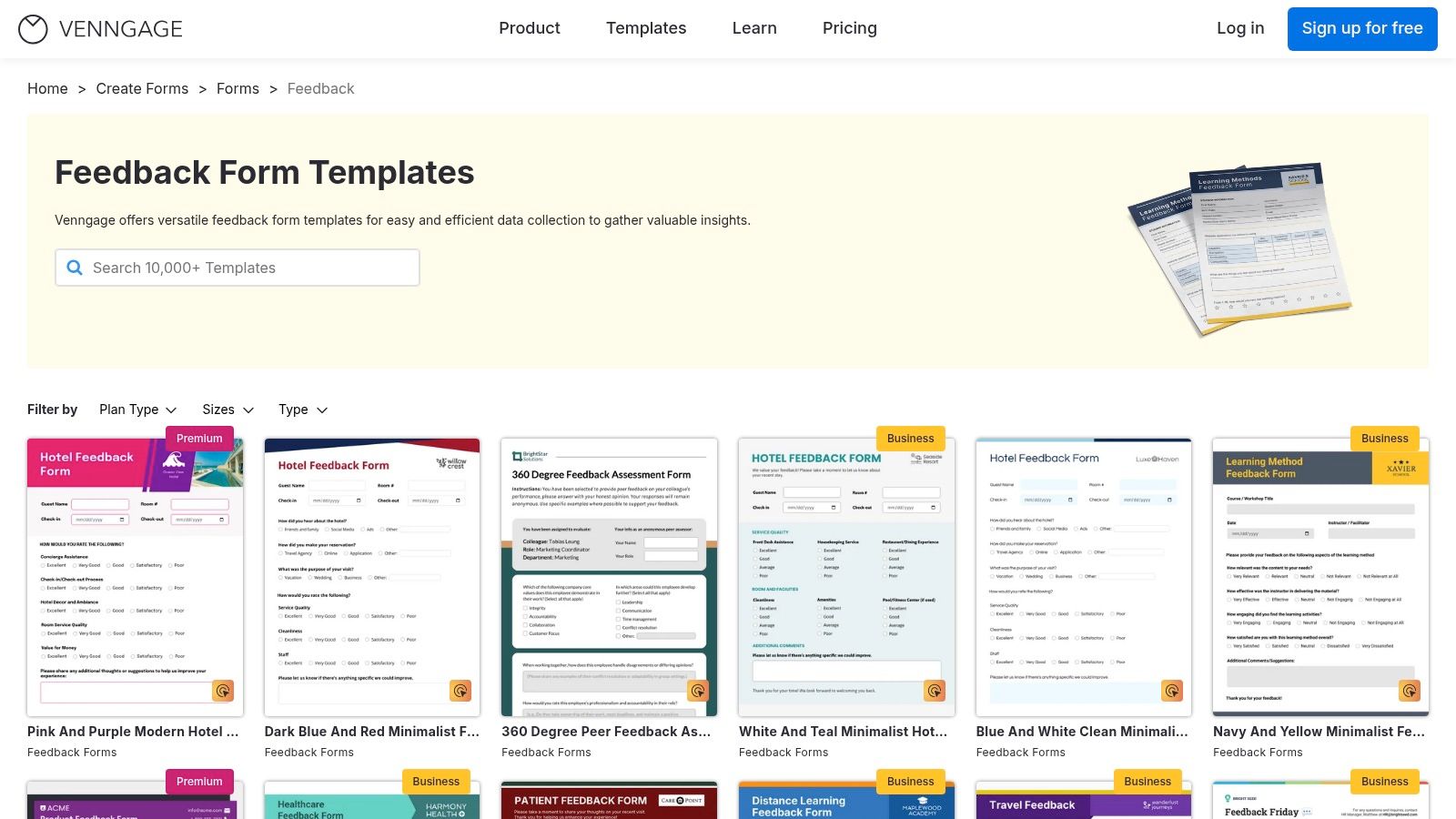
The platform's core strength lies in its user-friendly, drag-and-drop design editor. This allows marketing and customer success teams to heavily customize the look and feel of a feedback template, integrating brand colors, logos, and icons to create a visually engaging experience that stands out from standard, unstyled forms.
Use Case and Implementation
- Best For: Creating visually rich, printable, or shareable feedback documents, like internal employee review forms, customer journey maps with feedback points, or client project debriefs.
- Implementation Tip: Use Venngage to design the "shell" of your feedback form, then export it as a fillable PDF. This is an excellent workaround for collecting structured feedback when an interactive online form isn't necessary or practical, such as for formal client sign-offs or internal HR processes.
- Integration: Direct data integrations are not Venngage's focus. The primary workflow involves designing the form, exporting it (as a PDF, PNG, etc.), and then distributing it manually. Data collection would happen outside the platform.
Platform Breakdown
FeatureAssessmentEase of UseExcellent. The editor is intuitive, especially for those without a design background.CustomizationHigh. Strong focus on visual customization, branding, and layout design.Pricing ModelFreemium. The free plan has limitations on templates and features. A premium subscription is needed for advanced options like branding kits and exporting in high-resolution or PDF formats.Unique OfferingIts strength is in designing static, visually appealing forms and reports, rather than dynamic data collection.
Website: Venngage Feedback Form Templates
6. ClickUp
ClickUp is a comprehensive productivity and project management platform that extends its functionality into data collection with its own set of feedback form templates. While not a dedicated form builder, ClickUp's strength lies in its ability to directly integrate feedback collection into existing project workflows, making it ideal for teams who live inside the platform for their daily tasks.
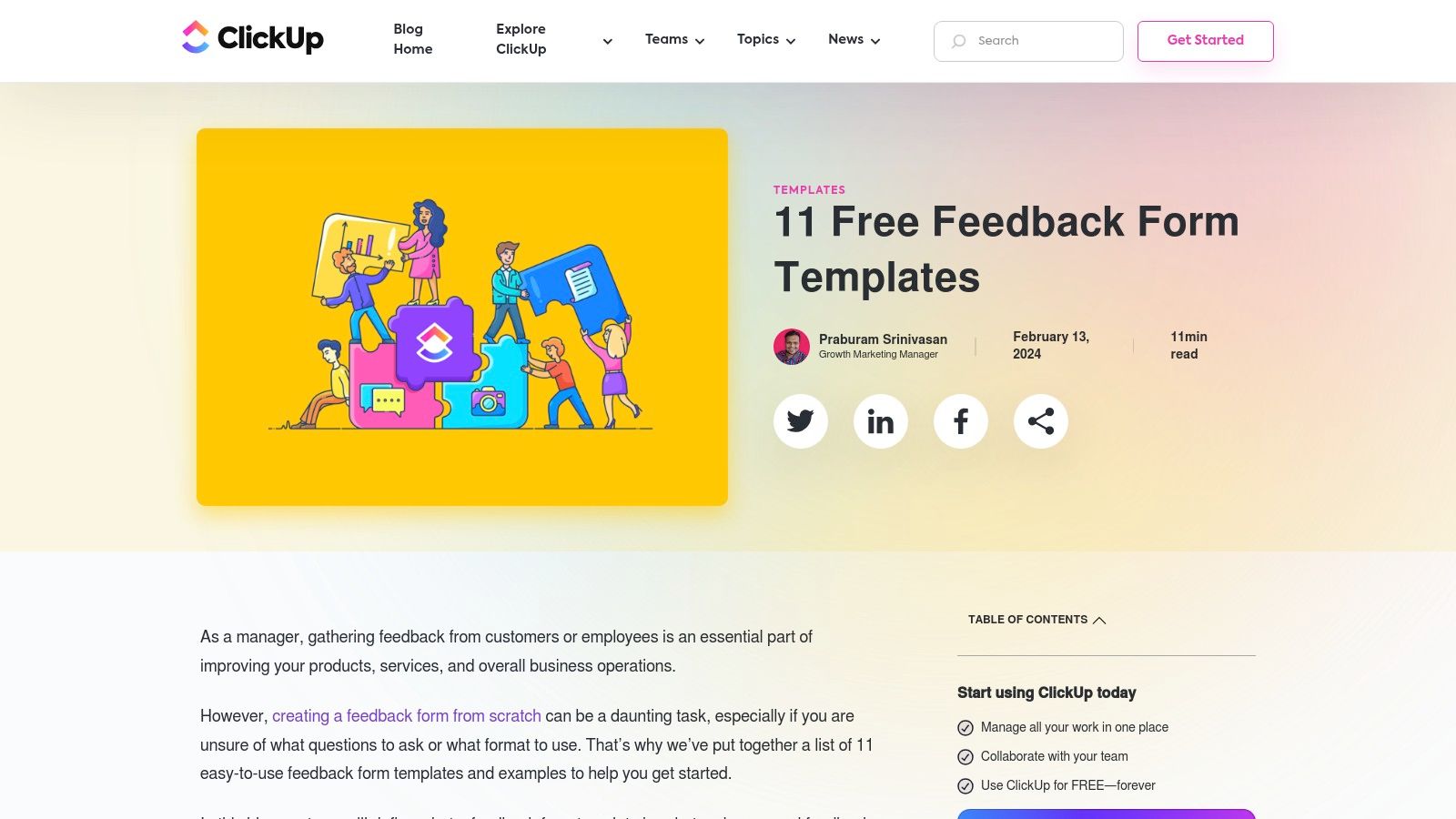
The primary differentiator for ClickUp is this native integration. When a user submits a feedback form, it can automatically create a new task within a specific project list, assign it to a team member, and set a due date. This eliminates the manual step of transferring feedback from a separate tool into your action plan, streamlining the entire feedback-to-action cycle.
Use Case and Implementation
- Best For: Agile development and product teams already using ClickUp for project management who want to seamlessly convert customer feedback into actionable tasks.
- Implementation Tip: Use ClickUp’s Automations with your forms. For instance, set up a rule that automatically assigns a "Bug Report" tag to any submission that includes the word "error" or "crash" and notifies the engineering team lead.
- Integration: As ClickUp is an all-in-one platform, its core benefit is internal integration. Feedback directly becomes part of your project management ecosystem, linking to tasks, docs, and sprints without needing a third-party connector like Zapier for basic workflows.
Platform Breakdown
FeatureAssessmentEase of UseVery Good. The form builder is straightforward, but leveraging its full potential requires familiarity with ClickUp's project management environment.CustomizationModerate. Offers good basic customization for fields and branding, but lacks the advanced design and logic options of dedicated form builders.Pricing ModelFreemium. The free plan is quite generous and includes forms. Paid plans unlock advanced features like more automations and storage.Unique OfferingThe ability to turn form submissions directly into tasks within a project management tool is its standout feature.
Website: ClickUp Feedback Form Templates
7. AidaForm
AidaForm positions itself as an accessible and analytics-driven tool for creating online forms. For teams seeking straightforward feedback form templates, it offers a clean, no-code solution that emphasizes ease of use from creation to analysis. The platform provides a solid collection of templates for common scenarios like customer satisfaction surveys and event feedback.
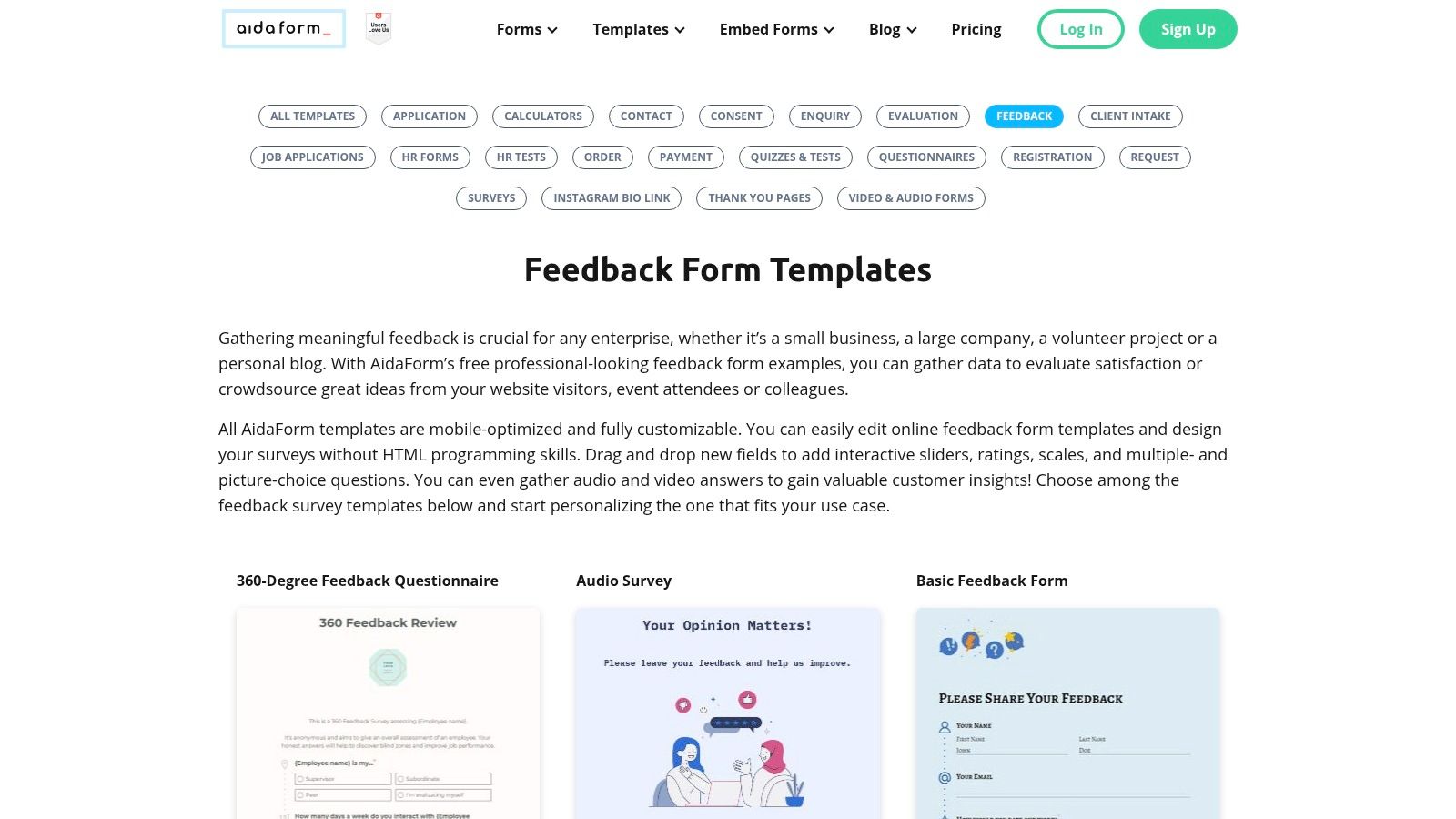
The platform’s standout feature is its built-in analytics and reporting dashboard. Unlike tools where data needs to be exported for analysis, AidaForm provides visual reports directly within the platform, making it easy for marketing and product teams to quickly gauge sentiment and identify trends without needing a separate business intelligence tool. The drag-and-drop builder is intuitive, ensuring a low learning curve.
Use Case and Implementation
- Best For: Small to mid-sized SaaS teams or startups that need a cost-effective way to not only collect feedback but also visualize the results quickly without complex integrations.
- Implementation Tip: After collecting a significant number of responses, use AidaForm’s "Reports" feature. You can filter responses by date or specific answers to drill down into the data. Share these direct report links with stakeholders to keep everyone informed on customer sentiment in near real-time.
- Integration: AidaForm connects with essential tools like Google Sheets, Slack, and Mailchimp. While its library isn't as vast as some larger competitors, it covers the core needs for automating feedback workflows and follow-up communications.
Platform Breakdown
FeatureAssessmentEase of UseExcellent. The interface is clean, and the drag-and-drop builder is simple for anyone to use.CustomizationGood. Offers solid design options, though less extensive than premium-focused builders.Pricing ModelFreemium. The free plan is quite generous. Paid plans unlock advanced features like logic jumps and more integrations.Unique OfferingIntegrated analytics and visual reporting are included even in the free tier, providing immediate value.
Website: AidaForm Feedback Form Templates
8. 123FormBuilder
123FormBuilder is a versatile and user-friendly form builder that provides a solid library of feedback form templates well-suited for SaaS teams. It strikes a balance between ease of use and powerful functionality, making it a strong contender for businesses that need to deploy various types of surveys without a steep learning curve. The platform is designed to get users from template to live form quickly.
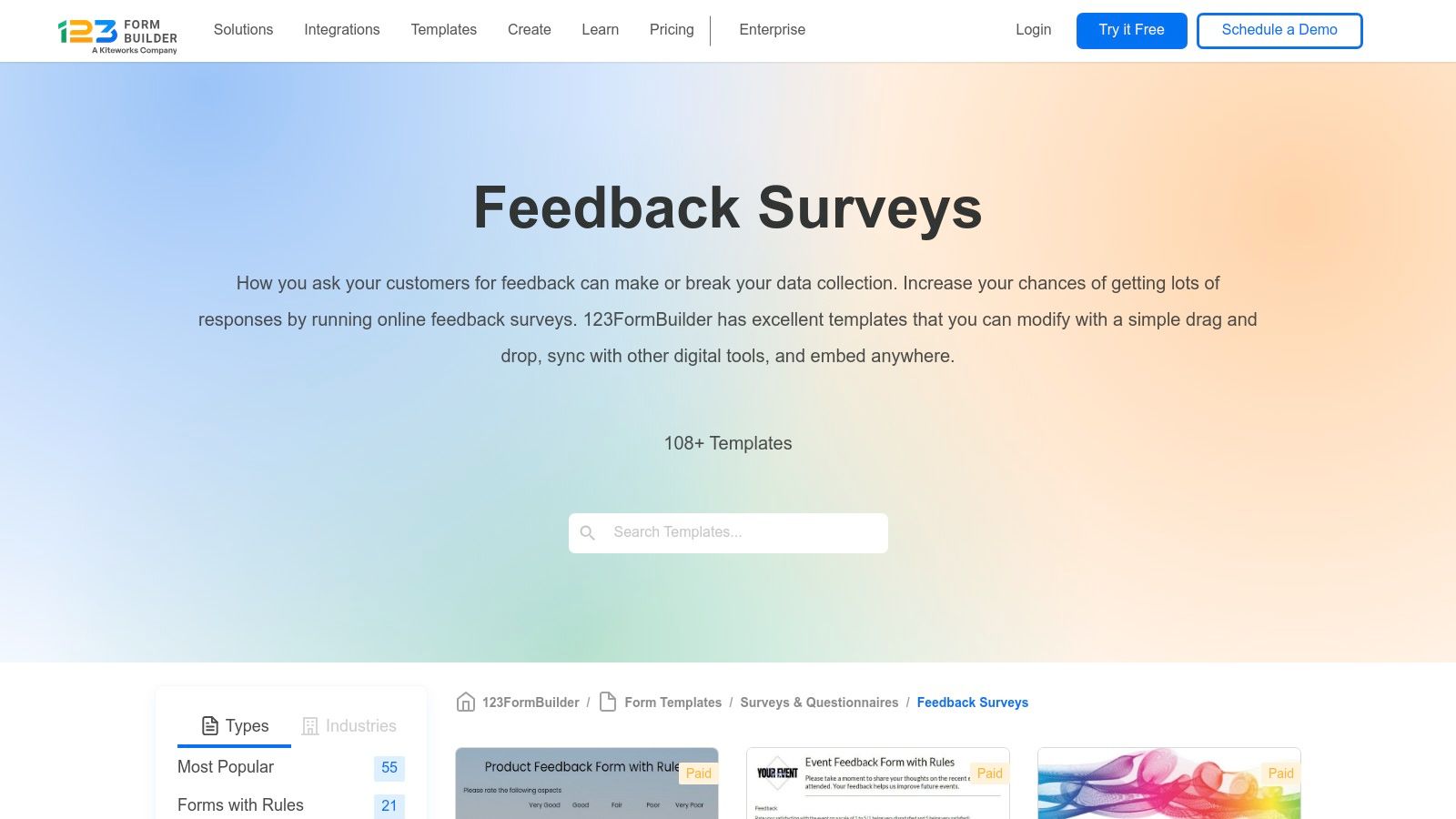
Its drag-and-drop editor is clean and straightforward, allowing for easy customization of fields, colors, and layouts. This makes it ideal for marketing and customer success teams who need to create on-brand forms for post-demo feedback, event satisfaction, or general website inquiries without relying on development resources.
Use Case and Implementation
- Best For: Teams looking for a reliable, all-around form builder with strong integration capabilities and a simple interface. It's particularly effective for collecting customer service feedback and employee satisfaction data.
- Implementation Tip: Take advantage of the built-in data analytics. After collecting responses, use 123FormBuilder’s reporting tools to generate quick charts and graphs. This helps visualize trends in customer feedback directly within the platform before exporting the data.
- Integration: The platform connects with popular business tools like Mailchimp, Salesforce, and Google Workspace. This allows you to automatically sync feedback submissions to your email marketing lists or CRM, ensuring that customer input is acted upon promptly.
Platform Breakdown
FeatureAssessmentEase of UseExcellent. The interface is highly intuitive, making form creation a simple process for all skill levels.CustomizationGood. Offers solid customization for form fields and design, though not as extensive as some enterprise-level competitors.Pricing ModelFreemium. The free plan is quite limited (5 forms, 100 submissions/month). Paid plans unlock more features, submissions, and remove branding.Unique OfferingIts combination of a straightforward editor, robust security features, and native integrations provides a well-rounded and dependable solution.
Website: 123FormBuilder Feedback Form Templates
9. Zendesk
Zendesk is a titan in the customer service software industry, and its approach to feedback is deeply integrated into its ecosystem. While not a standalone form builder, Zendesk provides a curated collection of feedback form templates specifically designed to streamline data collection within a support-centric workflow. These templates are engineered to capture insights at critical moments in the customer journey, such as after a support ticket is resolved or following a knowledge base article interaction.
The platform's key advantage is its native integration. For teams already using Zendesk for support, help desk, or sales, implementing these feedback forms is seamless. The data collected doesn't live in a silo; it directly enriches customer profiles and provides actionable context for support agents and success managers, making it an incredibly powerful tool for closing the loop on customer issues.
Use Case and Implementation
- Best For: Companies deeply embedded in the Zendesk ecosystem that want to tie customer feedback directly to support tickets and CRM data.
- Implementation Tip: Activate Zendesk's built-in Customer Satisfaction (CSAT) surveys. These one-question surveys can be automatically sent after a ticket is solved, providing a low-friction way to gauge agent performance and overall service quality. The results are then tied directly to the specific ticket and agent for easy tracking.
- Integration: The primary integration is, naturally, with Zendesk's own suite of products (Support, Guide, Sell). Feedback collected automatically populates within the Zendesk dashboard, creating a unified view of the customer. This removes the need for third-party connectors to your primary support tool.
Platform Breakdown
FeatureAssessmentEase of UseExcellent. For existing Zendesk users, enabling and customizing these forms is straightforward and part of the native admin experience.CustomizationModerate. While you can tailor questions and branding, the customization is less extensive than dedicated form builders and is constrained by the Zendesk UI.Pricing ModelIncluded with Plan. The feedback templates and core survey features are available as part of Zendesk's paid subscription plans. Access is not free or standalone.Unique OfferingThe seamless, native integration that pipes feedback directly into support tickets and agent performance dashboards is its core strength.
Website: Zendesk Feedback Form Templates
10. Template.net
Template.net positions itself as a vast repository for all kinds of business documents, and its collection of feedback form templates is no exception. Unlike dedicated form builders, this platform focuses on providing downloadable and editable document templates in formats like Word, Google Docs, and PDF, which can then be printed or shared digitally.
This makes Template.net a strong choice for teams that require offline feedback collection or need to integrate feedback forms into existing document-based workflows. The platform provides a simple online editor for basic customizations before downloading, offering a quick way to add a logo or change text without needing design software.
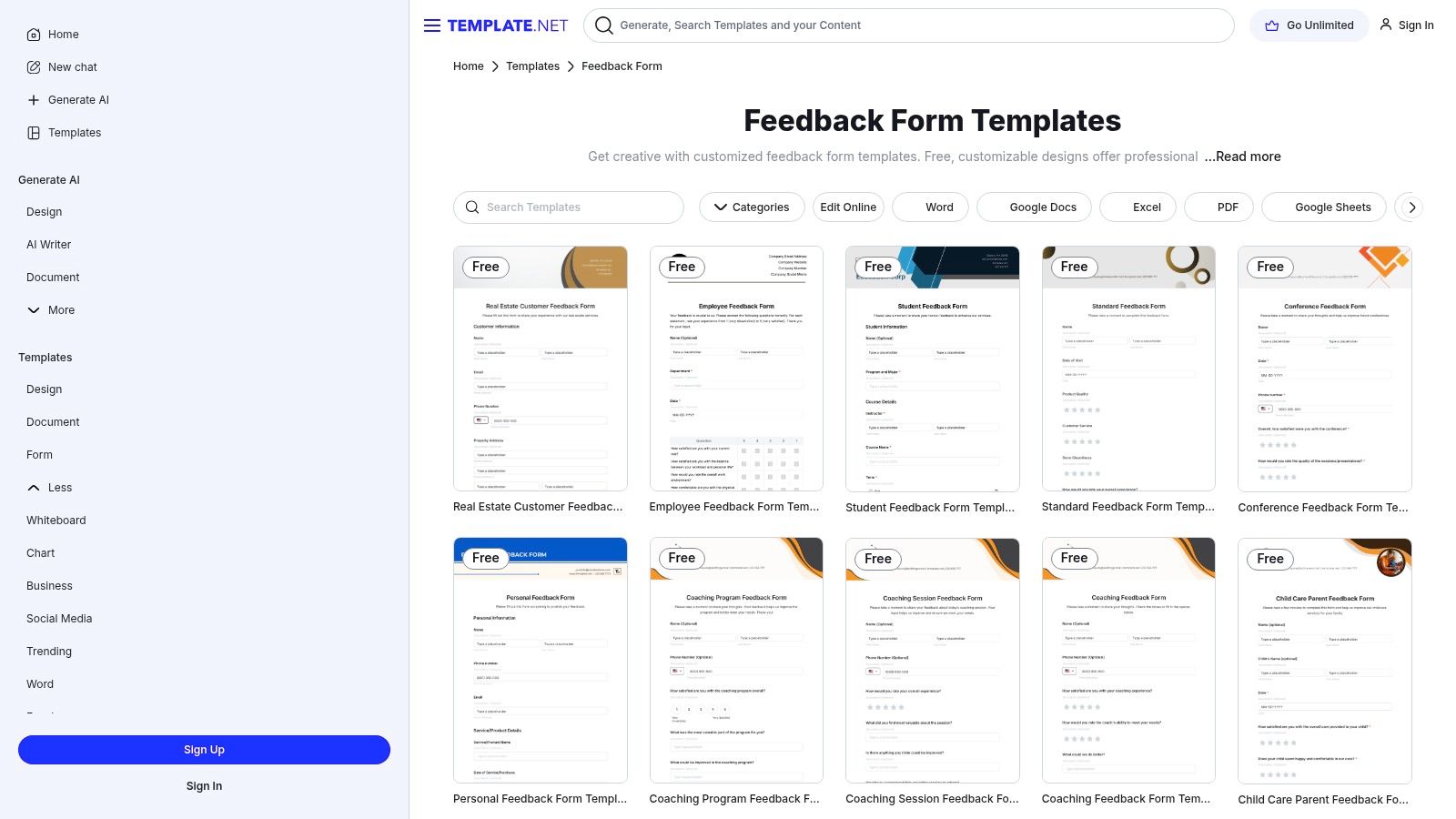
Use Case and Implementation
- Best For: Teams needing printable feedback forms for in-person events, physical product inserts, or internal HR processes where a digital-only solution isn't suitable.
- Implementation Tip: After customizing a template, download it in a format compatible with your team's software (e.g., Google Docs for collaborative editing). You can then convert the finalized document into a fillable PDF for easier digital distribution if you do not plan to print it.
- Integration: Direct software integrations are not applicable here, as it's a template repository, not a data collection tool. The workflow involves manually downloading the file and then uploading or entering the collected data into your systems like a CRM or spreadsheet.
Platform Breakdown
FeatureAssessmentEase of UseGood. The website is easy to navigate, and the online editor is straightforward for basic changes.CustomizationModerate. Customization is limited to what the chosen file format (e.g., Word, PDF) allows. It lacks the dynamic logic of form builders.Pricing ModelFreemium. Many templates are free to download, but a premium subscription is required for the best designs and advanced formats.Unique OfferingIts focus on traditional document formats (Word, Pages, PDF) makes it ideal for offline or print-based feedback scenarios.
Website: Template.net Feedback Forms
11. Paperform
Paperform positions itself as the "digital Swiss Army knife" for creators, and this versatility extends to its collection of feedback form templates. While not as vast as some competitors, its curated library of over 45 templates is designed with a strong emphasis on aesthetics and a conversational user experience, making feedback feel less like a chore and more like an interaction.
The platform's key differentiator is its free-text, document-style editor. Instead of dragging and dropping fields, you type slash commands (e.g., /question) to insert elements, which feels incredibly fast and natural for those accustomed to modern document editors. This approach helps teams create beautiful, branded forms that look more like dedicated landing pages.
Use Case and Implementation
- Best For: SaaS teams prioritizing brand aesthetics and a conversational, mobile-first feedback experience, particularly for customer onboarding, event feedback, or course evaluations.
- Implementation Tip: Leverage Paperform's powerful calculation fields. You can create scoring mechanisms for quizzes or satisfaction surveys directly within the form, allowing you to automatically calculate results and display custom success pages or messages based on the user's score.
- Integration: Paperform connects with over 3,000 apps via direct integrations and Zapier. This allows you to send feedback directly to project management tools like Asana, add respondents to email lists in Mailchimp, or populate data into a Google Sheet for analysis.
Platform Breakdown
FeatureAssessmentEase of UseExcellent. The unique "doc-style" editor is intuitive and fast for creating forms.CustomizationHigh. Strong control over visuals, fonts, colors, and layout to match brand identity.Pricing ModelSubscription-based. No free plan is offered, only a 14-day free trial. Paid plans are required for access.Unique OfferingThe landing-page-like feel of its forms and the intuitive slash-command editor.
Website: Paperform Feedback Form Templates
12. Visme
Visme positions itself as a design-first platform, and its approach to feedback form templates reflects this ethos. Instead of focusing on complex data collection, Visme empowers marketing and product teams to create exceptionally beautiful, on-brand forms that feel more like integrated marketing assets than standard surveys. The emphasis is on visual appeal and brand consistency.
The platform’s key differentiator is its powerful yet accessible design suite. It combines a drag-and-drop editor with professional-grade design tools, allowing non-designers to produce polished, visually engaging forms that capture user attention and reinforce brand identity, making it a strong choice for high-touch customer interactions.
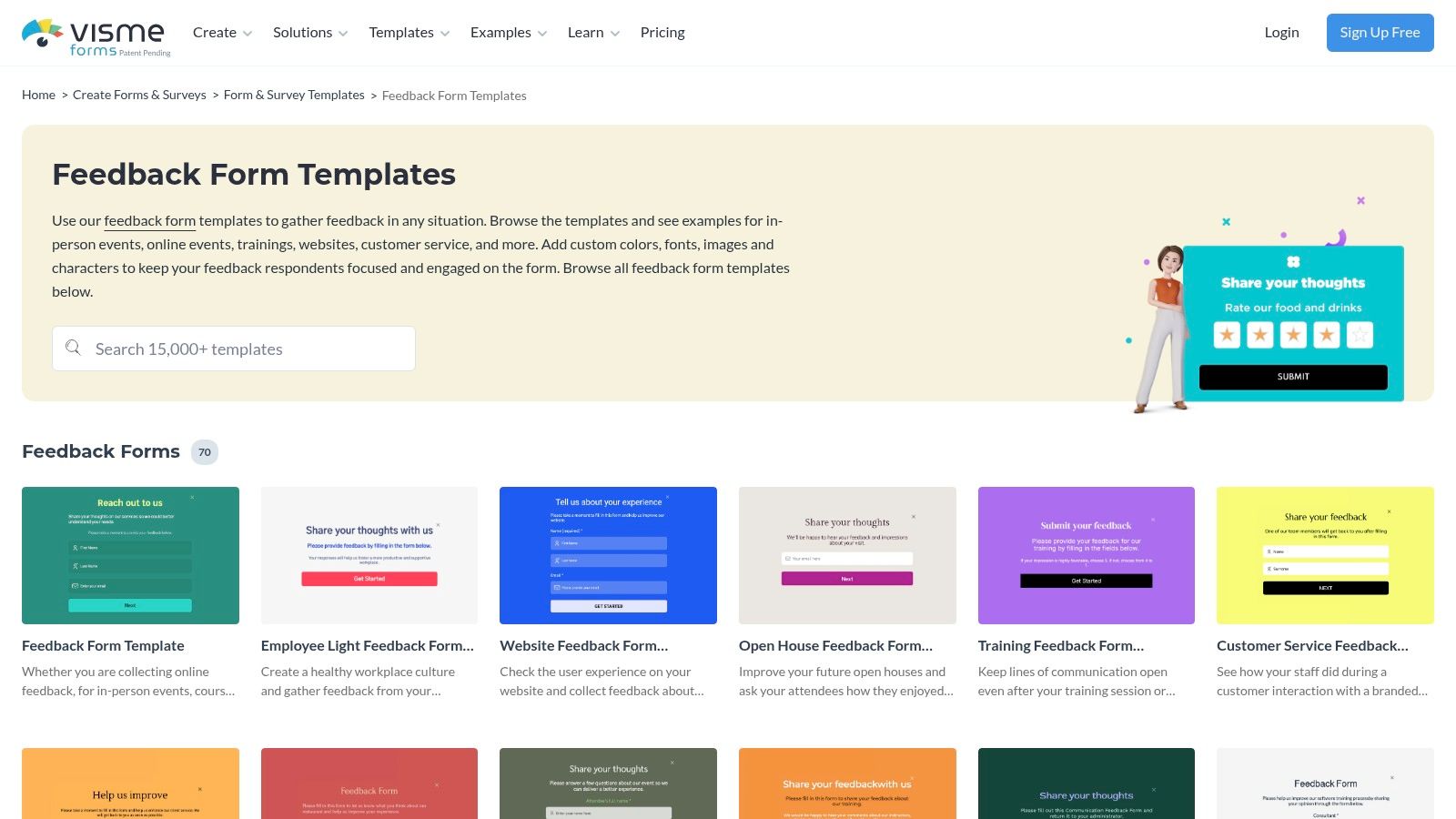
Use Case and Implementation
- Best For: Marketing teams wanting to embed visually stunning feedback forms into presentations, infographics, or web pages where brand aesthetic is paramount.
- Implementation Tip: Use Visme’s collaboration features to get design feedback from your team before publishing. This ensures the final form perfectly aligns with your brand guidelines and the campaign's visual language, which is crucial for maintaining a cohesive user experience.
- Integration: Visme's integration capabilities are more focused on content workflows than data piping. You can connect it to tools like HubSpot to gate forms, but it lacks the direct data integrations to project management or analytics tools seen in dedicated form builders.
Platform Breakdown
FeatureAssessmentEase of UseExcellent. The interface is intuitive, especially for those familiar with graphic design software.CustomizationHigh. Offers deep control over visual elements like fonts, colors, and layout.Pricing ModelFreemium. The free plan offers basic features and templates. A premium subscription is needed to unlock advanced templates, branding kits, and export options.Unique OfferingIts core strength is creating highly designed, branded forms that can be part of a larger visual content strategy (e.g., presentations, reports).
Website: Visme Feedback Form Templates
Feedback Form Templates: Top 12 Tools Comparison
PlatformCore Features ✨User Experience ★★★★☆Value Proposition 💰Target Audience 👥Unique Selling Points 🏆Price Points 💰Jotform10,000+ templates, drag-drop, integrationsUser-friendly, mobile-responsiveVersatile, robust integrationsSMBs, enterprisesExtensive templates, payment processingFree plan (limited) + paidTypeformConversational forms, logic jumpsHighly engaging, interactive designBoosts response ratesSaaS, marketing teamsInteractive UX, personalized surveysHigher-priced plansSurveyMonkeyAdvanced logic, real-time analyticsComprehensive, mobile-optimizedDeep insights, strong securityBusinesses of all sizesPowerful analytics & securityFree limited + tiersFormstackDrag-drop, automation, complianceEasy to use, secureWorkflow automation with security focusEnterprisesData security, workflow automationPremium pricingVenngageDesign templates, brandingEasy for non-designersDesign-focused branded formsMarketing, design teamsHigh-quality visuals, collaborationFree + PremiumClickUpFeedback forms, integrations, workflowsUser-friendly, project management integratedFree robust featuresTeams, project managersPM integration, automationFree + paid plansAidaFormDrag-drop, built-in analyticsNo coding, mobile-friendlyFree analytics-enabled formsSMBs, beginnersBuilt-in analytics, ease of useFree + paid plans123FormBuilder200+ templates, drag-drop editorEasy, mobile-responsiveStrong integration optionsSMBs, agenciesExtensive templates, analyticsFree limited + paid tiersZendeskCustomizable templates, analyticsSeamless Zendesk integrationFree with Zendesk ecosystemZendesk users, support teamsNative customer service integrationFree within ZendeskTemplate.netWide template range, online editingEasy customizationFree and premium templatesVarious industriesMultiple formats downloadFree + premiumPaperformCustomizable, payment integrationIntuitive, mobile-friendlyVersatile branded formsSMBs, marketersPayment processingNo free, trial onlyVismeDesign-focused, branding, collaborationEasy for non-designersDesign-centric branded materialsMarketing, creativesHigh-quality design templatesFree + premium
From Templates to Transformation: Activating Your Feedback
Navigating the landscape of feedback form templates can feel overwhelming, but as we've explored, the right tool is a powerful catalyst for growth. We've journeyed through a comprehensive list of platforms, from the versatile power of Jotform and Typeform to the integrated project management prowess of ClickUp and the specialized support workflows of Zendesk. Each offers a unique starting point for capturing the voice of your customer.
The core lesson is that a template is not the destination; it is the launchpad. The true transformation happens when you move beyond simple data collection and build an integrated system for understanding and acting on user insights. A beautifully designed form from Paperform or Visme is effective only when the data it gathers informs your product roadmap, refines your customer success strategy, and ultimately boosts retention.
Key Takeaways: From Selection to Strategy
Selecting the right tool requires looking past the surface-level features and aligning the platform's strengths with your specific operational needs.
- For Rapid Deployment & Versatility: Tools like Typeform, Jotform, and 123FormBuilder excel. They offer extensive template libraries and intuitive builders, making it easy for any team member, regardless of technical skill, to launch a survey quickly. Their strength lies in their adaptability for various use cases, from simple contact forms to complex multi-page customer satisfaction surveys.
- For Deep System Integration: Platforms like Formstack, Zendesk, and ClickUp shine when embedded within your existing tech stack. The goal here isn't just to ask questions but to pipe the answers directly into your CRM, helpdesk, or project management boards, turning feedback into actionable tasks automatically.
- For Visual & Brand-Centric Communication: When brand consistency is paramount, Venngage and Paperform provide robust design customization. These tools allow you to create forms that feel like a seamless extension of your product, enhancing the user experience and encouraging higher completion rates.
Beyond the Form: Activating Your Data
The most critical step in this entire process is what happens after a user clicks "submit." A folder full of survey responses is a missed opportunity. To truly activate feedback, consider how forms can integrate with other tools, for instance by automating feedback export from Google Forms to PDF for streamlined reporting and sharing with stakeholders who aren't in the primary tool.
This principle of activation is central to a mature feedback strategy. Your goal should be to create an automated, intelligent loop where feedback doesn't just sit in a database but actively triggers workflows. For SaaS teams, this means connecting user sentiment directly to business outcomes. A user expressing frustration with a feature should trigger an alert for the product team, while a customer signaling churn risk should initiate a retention flow managed by your customer success team.
Ultimately, the most effective feedback form templates are those that serve as the entry point to a larger, more dynamic system. The initial data collection is just the first conversation starter. The real value is unlocked in the follow-up, the analysis, and the decisive actions you take in response. By choosing your tools strategically and building a process to listen, analyze, and act, you can convert user feedback from a passive resource into your most reliable engine for sustainable growth and product innovation.
Ready to move from static forms to an active feedback system that prevents churn and drives growth? Surva.ai is built specifically for the SaaS lifecycle, turning customer insights from tools like these into automated retention actions. Start building intelligent, proactive feedback loops today at Surva.ai.
